The Path to R&D Innovation Lies in the Power of Small Pharma
Visionary thought leaders such as Bernard Munos of InnoThink and the Milken Institute and Paul Stoffels, M.D., vice chairman of the executive committee and chief scientific officer, Johnson & Johnson, have been advocating for years that the blockbuster model is broken and unsustainable. They have been pushing for a change in the R&D model that will drive more 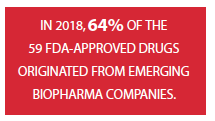 transformational innovation. That day of transformation may be upon us, as small biotech and large pharma companies have started to work synergistically to create a faster, more cost-effective way to bring new treatments to market.
transformational innovation. That day of transformation may be upon us, as small biotech and large pharma companies have started to work synergistically to create a faster, more cost-effective way to bring new treatments to market.
The short story is that small pharma brings nimbleness and a focused-approach to science that is uninhibited by the bureaucracy of large pharma, and large pharma provides the funding and the sales and marketing muscle to bring these innovative drugs to patients. This symbiotic relationship has proven to be a win-win.
This trend has been growing rapidly over the past five years within the industry’s R&D model. Gone are the guarded, years-long, high-cost searches for a blockbuster that was so common years ago for large pharma companies. Today, small pharma companies are overwhelmingly driving innovation, accounting for 63% of all new prescription drug approvals over the past five years. A report by HBM partners showcases this trend by tracking the NMEs that were originally developed by small, mid-sized, and big pharma companies. In 2009, small pharma was responsible for discovering 31% of NMEs; now jump to 2018, when 64% of all NME approvals originated from small pharma, a 103% increase over 2009.
Big pharma’s new role in this is to partner and fund the innovation that it so sorely needs to bulk up its dwindling pipelines. This is a cost-effective move for larger drug companies to leverage outside scientific talent to gain access to breakthrough discoveries.
“This is a dominant trend in the industry," says Nach Davé, VP, development strategy, Premier Research. “Large pharma is deciding that rather than take the risk of developing a 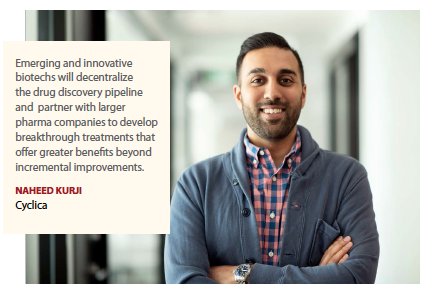 single drug over the course of seven to 10 years and spending $7 billion, these companies are taking their chances on innovative, small companies."
single drug over the course of seven to 10 years and spending $7 billion, these companies are taking their chances on innovative, small companies."
“The future R&D model will leverage the synergy that develops between those small companies, the grassroots innovators, and the remaining big pharma companies," Mr. Munos, who is also a fellow at FasterCures, a Center of the Milken Institute, says. “There will still be challenges that will require scale to be overcome. Small entrepreneurial companies can do quite a lot, but they won’t be able to completely replace the capabilities of their big pharma counterparts."
Mr. Davé predicts that small, innovative companies will continue to “do what they do best" in terms of science and be funded by large capital coming from the large pharma. Not only do big pharma companies have deep pockets but they also have the salesforces and the marketing muscle to get new drugs out to the masses. “It’s a very nice dynamic for the future and I see this model continuing to grow and get stronger and stronger," he says.
Large pharma companies will never lose the marketing and sales muscle they have to drive the product to the marketplace, and that works well for the small biotech companies. “The relationship that we have now is very symbiotic and it’s advantageous when everyone continues to work in their own individual ecosystems," Mr. Davé says.
He provides a real-life example of how this new symbiotic relationship and the ecosystem works. In the rare disease space, a small biotech company was developing a biologic that would treat only 700 people worldwide. The science was solid but getting funding was a struggle. “There weren’t a lot of people lining up to support a product that was going to have only 700 customers in the world," Mr. Davé says. “And the price tag for development is the same whether developing a rare disease drug or a traditional hypertensive drug."
Enter a large pharma partner operating in the oncology space. The pharma company was interested because the rare disease being addressed was a precursor to cancer, and the large 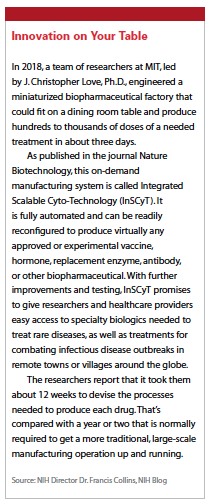 pharma company saw funding the innovation as an opportunity. With that funding relationship came access to the biotech’s voucher that can be used to accelerate the timeline of any drug in the pipeline, which would prove very valuable to the large pharma partner.
pharma company saw funding the innovation as an opportunity. With that funding relationship came access to the biotech’s voucher that can be used to accelerate the timeline of any drug in the pipeline, which would prove very valuable to the large pharma partner.
Mr. Davé says the infusion of money from the large pharma company allowed the small biotech to produce a solution for 700 patients in the world and keep the price tag of the drug to a respectable level where it is still affordable and able to be reimbursed.
Over time, the budding relationships between large and small pharma may evolve to the point of a new business and R&D model across the entire industry. “We have started to witness a shift in the balance of power over the past decade, with a burst of innovation from the early-stage and emerging biotech companies," says Naheed Kurji, CEO, Cyclica. “As the market landscape for drug discovery evolves, early-stage biotechs are increasingly entering the spotlight with a combination of subject-matter expertise in the science and the benefits of a lean organization conducive to rapid innovation."
“The industry has become more open-minded about its business model, and more companies are getting bolder and starting to implement new ways of doing business," Mr. Munos says. “The pharmaceutical industry used to be built on proprietary knowledge, tools, science, and data. This has changed."
Innovation is now being energized by countless “mad scientists," as Mr. Munos calls them, who work out of academia, incubators, or virtual companies.
“They add up to a giant grassroots innovation movement that operates on a shoestring," he says. “Together, they explore emerging biology, and are quick to embark on translation when they spot an opportunity. It used to be that a biotech startup would need $50 million to get going because it had to recreate all the functions of a big company — HR, legal, and everything else. Today, companies don’t need this type of infrastructure. They can turn to crowdsourcing platforms, like scientist.com, for example. So, if you’re a chemist you focus on chemistry and procure everything else from the crowdsourcing platform when you need it. This flexibility has changed the dynamics of innovation. Startups now have the opportunity to grow without adding scale. This is a pretty valuable feature."
Crowdsourcing a Startup
“The crowdsourcing model is remarkable because it used to be that if someone wanted to start up a company, he or she needed to excel in everything, because the expertise was needed inside the company; procuring resources wasn’t very easy and the market was not transparent or efficient," Mr. Munos says. “Today, if a company wants somebody to design a trial, clone a peptide, do a toxicology study, or synthesize one gram of a molecule, it can be easily resourced. All someone has to do is send an email to a crowd-sourcing platform and say, ‘Hey, I need that. Can you help?’"
There are several factors that have inspired and validated this model, effectively changing the pipeline in which medicines are brought to market. First, the patent cliff, as well as a significant decrease in new R&D returns, and the lack of discovery of more blockbuster drugs, to name a few. All of these factors led to big pharma looking toward smaller biopharma companies to develop innovations that it could not.
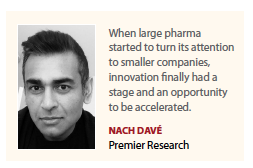 “Early-stage biotech companies are seizing the opportunity to grab their share of the market, with recent data from IQVIA suggesting that emerging biotech companies now account for more than 70% of the total R&D pipeline, up from 52% in 2003," Mr. Kurji says. “Emerging and innovative biotechs will continue to decentralize the drug discovery pipeline and develop breakthrough treatments that offer greater benefits beyond incremental improvements and reshape the way medicines are discovered and brought to market."
“Early-stage biotech companies are seizing the opportunity to grab their share of the market, with recent data from IQVIA suggesting that emerging biotech companies now account for more than 70% of the total R&D pipeline, up from 52% in 2003," Mr. Kurji says. “Emerging and innovative biotechs will continue to decentralize the drug discovery pipeline and develop breakthrough treatments that offer greater benefits beyond incremental improvements and reshape the way medicines are discovered and brought to market."
Funding Gets Easier
This emerging paradigm makes it easier for small or emerging companies to get funding, whereas before it was one of their biggest hurdles.
When small biotechnology companies had to rely on venture capital only, funding was difficult. If the VC-driven environment lost confidence in the biotechnology space or if fund managers lost confidence in certain medical innovations then the money stopped flowing in.
“Now, there is another player that has come to the table and that is large pharma, which has very deep pockets," Mr. Davé says. “So, when a VC will not fund an innovative company or innovative product, these companies have at least another suitor that can fill that gap — big pharma."
According to Mr. Kurji, large pharmaceutical companies are definitely supporting the creation, early-seed financing, and later-stage investment in biotech companies through their venture arms, but he also sees the venture capital ecosystem warming up to small pharma.
“There has been considerable interest in the small pharma and biotech industry, which has certainly captured the attention of VCs," he says. “StartUp Health in its Q3 insights reports that there has been a considerable increase in both the funding amount and deal counts in the healthcare and pharma space. In 2010, there was $1.1 billion with 152 deal counts, which is in stark comparison to the $10.4 billion and 556 deals by Q3 of 2019, with the largest amount of funding focused on earlier stage healthcare companies."
Not only has there been an increase in the number of deals and funding, there has also been an increase in the pool of investors supporting smaller biotechs and healthcare companies, with 1,061 unique investors participating in the industry, compared with 299 in 2012.
A large proportion of these investors are based in the United States, and most venture investments are focused around companies in Silicon Valley and Boston. There also has been recent growth in the Asian markets, particularly in China.
“As the market evolves, we will see a greater decentralization of resources as big pharma, non-profit organizations, and venture capital firms seek further innovation opportunities," Mr. Kurji says.
Pharma Spinoffs Spur Innovation
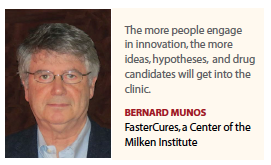 In addition to funding innovation from outside sources, sometimes large pharmaceutical companies create their own spinoffs to discover and develop innovative products as an independent arm of the larger business. This model may operate differently from an independent startup, but there are many advantages over the cumbersome R&D model of big pharma.
In addition to funding innovation from outside sources, sometimes large pharmaceutical companies create their own spinoffs to discover and develop innovative products as an independent arm of the larger business. This model may operate differently from an independent startup, but there are many advantages over the cumbersome R&D model of big pharma.
“There are a number of pharma spinoffs that have emerged over the past decade," Mr. Kurji says. “These spinoff companies typically take programs that have been discontinued or slowed down within the larger pharma company’s operations, and progress those programs independently with the appropriate rights and licenses. Cerevel is a great example, which spun out of Pfizer and is funded by Bain Capital. Cerevel is pursuing neurodegenerative disease, a therapeutic area that Pfizer recently divested its internal efforts."
According to a company release, Pfizer is contributing a portfolio of precommercial neuroscience assets to Cerevel, which includes three clinical-stage compounds and several preclinical compounds designed to target a broad range of CNS disorders, including Parkinson’s, Alzheimer’s, epilepsy, schizophrenia, and addiction.
Funds affiliated with Bain Capital Private Equity and Bain Capital Life Sciences have committed $350 million with the ability to provide additional capital should it be needed in the future.
Bain Capital and Pfizer will support Cerevel in building a dedicated team of CNS scientists and life-sciences executives with extensive experience in clinical development of potential therapies for patients who have neurological and neuropsychological diseases.
“Unquestionably, pharma spinoffs operate differently from independent startups in two critical ways," Mr. Kurji adds. “One, from the ideation of a pharma spinoff, there is a clear objective and strategy, and a visibility back to the pharma company, and two, the venture arms of a big pharma company are key as they financially support the ideation and creation of new companies that are strategically aligned to the pharma company’s mandates."
While the hurdles that independent startups face are much higher than those of pharma spinoffs, there are advantages to being independent, he says. “An independent startup has more freedom to operate and try new things and pivot along the journey," Mr. Kurji says.
Mr. Davé says the incubator concept within large pharma started gaining ground about three years ago.
“Large pharma companies started to create their own incubators and attract talent to those incubators," he says. “I’ve seen many cases where top scientists from the academic space have shifted over to large pharma incubators where they’re still doing the same thing but the opportunities to advance their science and technology are better, because of the infrastructure that a large pharma company can provide."
Many large pharma companies have started to move in this direction, realizing that it was a way to thrive and prepare for the transformation that is taking place in the industry.
“I’d say half of the top 12 pharma companies have a pretty good understanding of what’s going on," Mr. Munos says. “They started long ago to prepare themselves for the transformation that is taking place. For instance, I remember when I first met Dr. Stoffels 10 years ago he would tell anyone who cared to listen that the model was broken and needed changing."
Not surprisingly, years later, Dr. Stoffels was instrumental in developing JLABS at J&J, which now comprises 12 pharma incubators which are mentored but not funded by J&J, according to Mr. Munos. “This allows JLABS to explore emerging biology in 400 directions, something that could never be done within the company because it would raise its risk profile to unacceptable levels," he says.
“But the purpose is to unleash innovation and it is working great guns."
Mr. Munos also notes that Novartis, AstraZeneca, Bayer, Takeda, Boehringer Ingelheim, and Merck KGaA have retooled themselves in ways that have re-energized innovation.
The round up in his own words: “Novartis has gone through various iterations or versions of its innovation model. This was one of the first companies to return to scientists the freedom to innovate and the company has become one of the most prolific innovators, with 20 drugs approved in the last 10 years. AstraZeneca had a difficult transition, but its new drug output is rejoining the company to the leading innovators. Interestingly the mid-size companies such as Bayer, Takeda, Boehringer Ingelheim, Merck KGaA, seemed to have felt the heat a little sooner than their larger peers. But they all came to the realization that they needed to act in order to thrive in the new environment and they came up with new innovation models that have been remarkable. Takeda is a prime example of what we’re discussing because it used to be a rather staid company. Likewise, Boehringer Ingelheim came up with its own approach after realizing that much of the high-value innovation comes from outside. So it created a “research-beyond-borders" model that aims at harnessing new innovation ripples before they become waves. And its leadership has been pretty savvy at doing this. And Merck KGaA has taken multiple initiatives to basically implement open source R&D within its corporate structure.
“All this is taking place as we speak and it is changing the dynamics of research by boosting new drug approvals while harnessing the shoestring economics of startups," Mr. Munos continues. “Basically, this is opening pathways to overcome the pricing and affordability challenges that companies have been facing. It is putting the industry back on a sustainable course."
“When large pharma companies started to turn their attention to smaller biotech and emerging companies, innovation finally had a stage and an opportunity to be accelerated," Mr. Davé says. “While we’re not producing $1 billion drugs, we are producing many more drugs that are providing solutions to a wider range of patients who were ignored or unattended to from a therapeutic perspective. Large pharma’s shift in focus away from billion-dollar drugs to more innovative drugs has proved beneficial to patients."
With more companies and people engaging in innovation, there will be more ideas, more hypotheses, and more drug candidates that make it to the clinic. Scientific breakthroughs are quickly followed by the creation of multiple well-funded startup companies to exploit the new opportunities.
“This wasn’t the case 10 years ago, but now it’s become routine," Mr. Munos says. “The reality is that if innovation is getting cheaper, we’re going to see more of it, and that’s exactly what is happening."
Mr. Munos adds this as a “very exciting time" in the industry and there are many reasons to be optimistic about the future of the pharmaceutical industry. He anticipates that entrepreneur scientists and small companies will have a much easier route to achieving their goals than they have in the past.
“There will be a lot of turbulence in the near term, but in another five to 10 years or so, the industry will be on much better footing," Mr. Munos says.(PV)
~~~~~~~~~~~~~~~~~~~~~~~~~
Innovation on Your Table
In 2018, a team of researchers at MIT, led by J. Christopher Love, Ph.D., engineered a miniaturized biopharmaceutical factory that could fit on a dining room table and produce hundreds to thousands of doses of a needed treatment in about three days.
As published in the journal Nature Biotechnology, this on-demand manufacturing system is called Integrated Scalable Cyto-Technology (InSCyT). It is fully automated and can be readily reconfigured to produce virtually any approved or experimental vaccine, hormone, replacement enzyme, antibody, or other biopharmaceutical. With further improvements and testing, InSCyT promises to give researchers and healthcare providers easy access to specialty biologics needed to treat rare diseases, as well as treatments for combating infectious disease outbreaks in remote towns or villages around the globe.
The researchers report that it took them about 12 weeks to devise the processes needed to produce each drug. That’s compared with a year or two that is normally required to get a more traditional, large-scale manufacturing operation up and running.
Source: NIH Director Dr. Francis Collins, NIH Blog
~~~~~~~~~~~~~~~~~~~~~~~~~
Emerging Company Trends
Emerging biopharma companies account for 72% of all late-stage pipeline activity, up from 61% a decade ago. During the next five years, trial productivity will be heavily influenced by 8 key trends, according to an IQVIA Clinical Development Trends Impact Assessment.
1. Digital health technologies will enable the capture of drug efficacy and safety data remotely, which can improve patient safety, enable virtual trial formats, and ease site work burden.
2. Patient-reported outcomes will shed new light on patient experience and drug efficacy and safety outside the clinical setting and lead to accelerated trial times as endpoints shift.
3. Real-world data will optimize trial design, speed investigator and site selection, and enable new trial designs by acting as virtual control arms and supporting pragmatic, adaptive, and RWE registry trials.
4. Predictive analytics and artificial intelligence will identify new clinical hypotheses, reduce trial design risks and speed enrollment by identifying protocol-ready patients.
5. Shifts in types of drugs tested, for instance, to targeted therapies and next-generation biotherapeutics that improve efficacy and success rates and have accelerated development timelines but require longer-term patient follow-up.
6. Biomarker testing availability to help narrow patient populations to those more likely to see effect, resulting in improvements in efficacy, safety and success.
7. Regulatory landscape changes will encourage the adoption of precision medicine approaches, novel trial designs, and endpoints while providing means for accelerated drug approvals and regulatory success.
8. Pools of pre-screened patients and direct-to-patient recruitment will facilitate enhanced trial enrollment, shortened trial duration, and faster market availability.
Source: IQVIA Institute for Human Data Science Study

















